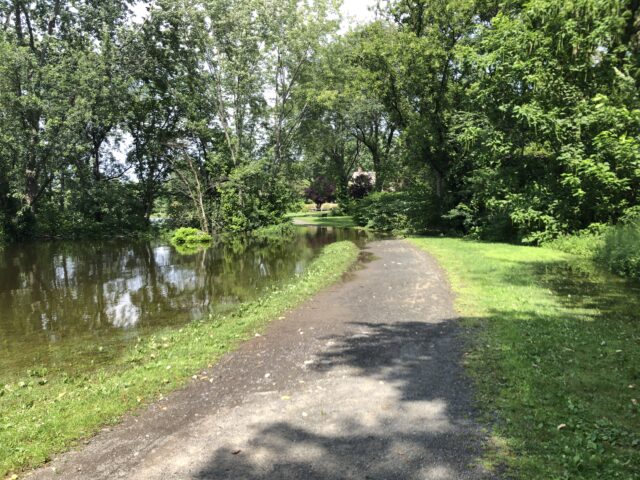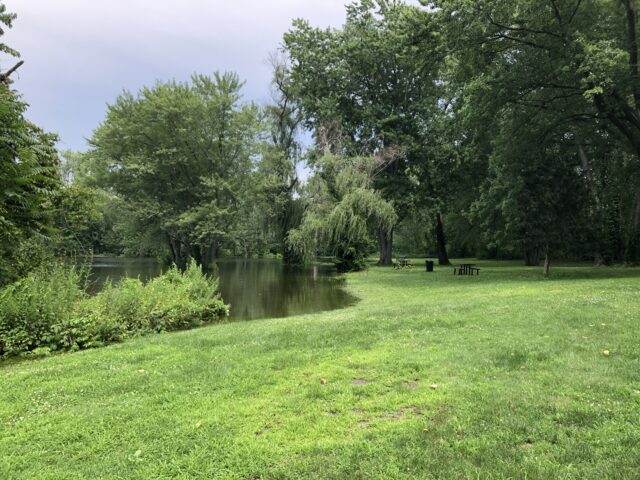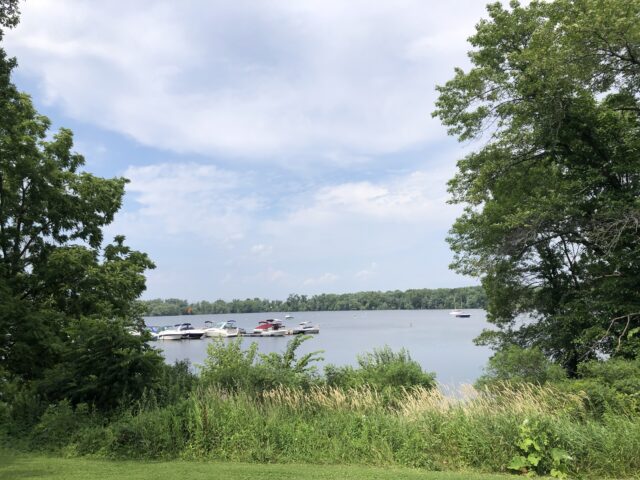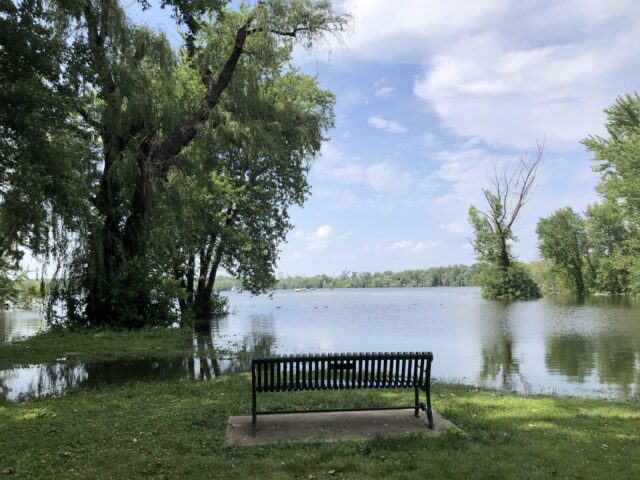This is how Wethersfield Cove, just south of Hartford, looked on Thursday.
It’s not so bad here, standard spring flooding. Until you remember that this is July.

There is a cost to maintaining the status quo, and one way to begin computing it is by looking at Vermont in July 2023.

In the Vermont flood areas, there have been many costs.
At least one person died, having drowned in his home.
There is the harm caused by stress.
Illness may follow.
There’s property loss and damage. There’s the resources required to repair and rebuild, along with the financial costs of those resources. Or, for some, the cost of starting over elsewhere. There’s the cost of stopping work on everything else to deal with this.

Downstream – literally and figuratively – there are costs.
Floodplains that were historically beneficial for farming, now pose a risk. Spring floods deliver nutrients to the fields not yet planted. A summer flood? That’s another thing entirely, drowning crops with water polluted from everything knocked loose up north.
There are still other costs. Commutes are disrupted when riverside paths are submerged. The bike path pictured along Wethersfield Cove is fairly easy to work around but that is not the case everywhere.
Outdoor recreation is impacted: boating in floodwater is not advised, and neither is swimming. Add to that, what is recreation for some (a nice river cruise) is income for someone else (river boat owner). Those planning trips to parts of Vermont have had to cancel. Train service in Vermont has been suspended.
That’s just a quick, non-exhaustive list for how one weather event impacted a region during what happened to be the hottest week in recorded history.

In September, like every year, the Connecticut River Conservancy will be holding its Source to Sea Cleanup days – most around September 22 and 23, 2023. People can register a site they’d like to clean or find one to join. Already, there is a cleanup scheduled in Wethersfield and another in Hartford. Volunteer registration opens in August. There’s something for everyone, whether what pulls you in is beautifying the Connecticut River, reducing the amount of harmful debris that might be consumed by fish and birds, or sorting and tallying litter to determine what is turning up and how we can prevent that in the future. Last year’s effort diverted over 34 tons of trash from streams and rivers, preventing it from entering Long Island Sound. Plastic bottles were the most prevalent type of beverage container fished out of the water or off river banks. Styrofoam, scrap metal, PPE and pharmaceuticals were fairly common finds. It’s fair to expect more of that this year, plus whatever was sent from Vermont but didn’t manage to find its way already onto beaches on the shore.
Photograph: Wethersfield Cove
Climate Possibilities is a new series about climate mitigation, along with resilience, resistance, and restoration. It’s about human habitat preservation. It’s about loving nature and planet Earth, and demanding the kind of change that gives future generations the opportunity for vibrant lives. Doomers will be eaten alive, figuratively. All photographs are taken in Hartford, Connecticut unless stated otherwise.
Après moi, le déluge
This is how Wethersfield Cove, just south of Hartford, looked on Thursday.
It’s not so bad here, standard spring flooding. Until you remember that this is July.
There is a cost to maintaining the status quo, and one way to begin computing it is by looking at Vermont in July 2023.
In the Vermont flood areas, there have been many costs.
At least one person died, having drowned in his home.
There is the harm caused by stress.
Illness may follow.
There’s property loss and damage. There’s the resources required to repair and rebuild, along with the financial costs of those resources. Or, for some, the cost of starting over elsewhere. There’s the cost of stopping work on everything else to deal with this.
Downstream – literally and figuratively – there are costs.
Floodplains that were historically beneficial for farming, now pose a risk. Spring floods deliver nutrients to the fields not yet planted. A summer flood? That’s another thing entirely, drowning crops with water polluted from everything knocked loose up north.
There are still other costs. Commutes are disrupted when riverside paths are submerged. The bike path pictured along Wethersfield Cove is fairly easy to work around but that is not the case everywhere.
Outdoor recreation is impacted: boating in floodwater is not advised, and neither is swimming. Add to that, what is recreation for some (a nice river cruise) is income for someone else (river boat owner). Those planning trips to parts of Vermont have had to cancel. Train service in Vermont has been suspended.
That’s just a quick, non-exhaustive list for how one weather event impacted a region during what happened to be the hottest week in recorded history.
In September, like every year, the Connecticut River Conservancy will be holding its Source to Sea Cleanup days – most around September 22 and 23, 2023. People can register a site they’d like to clean or find one to join. Already, there is a cleanup scheduled in Wethersfield and another in Hartford. Volunteer registration opens in August. There’s something for everyone, whether what pulls you in is beautifying the Connecticut River, reducing the amount of harmful debris that might be consumed by fish and birds, or sorting and tallying litter to determine what is turning up and how we can prevent that in the future. Last year’s effort diverted over 34 tons of trash from streams and rivers, preventing it from entering Long Island Sound. Plastic bottles were the most prevalent type of beverage container fished out of the water or off river banks. Styrofoam, scrap metal, PPE and pharmaceuticals were fairly common finds. It’s fair to expect more of that this year, plus whatever was sent from Vermont but didn’t manage to find its way already onto beaches on the shore.
Photograph: Wethersfield Cove
Climate Possibilities is a new series about climate mitigation, along with resilience, resistance, and restoration. It’s about human habitat preservation. It’s about loving nature and planet Earth, and demanding the kind of change that gives future generations the opportunity for vibrant lives. Doomers will be eaten alive, figuratively. All photographs are taken in Hartford, Connecticut unless stated otherwise.
Related Posts
Closing the Power Gap
Ink and Time
Look: Peace and Paint